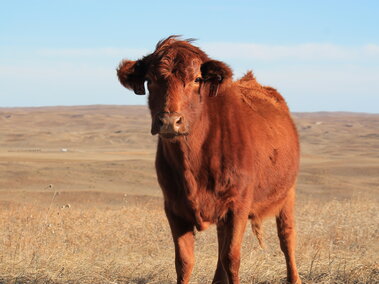Impact of overwinter gain on growth and reproductive performance in March-born heifers.
Josie Crouch
Replacement heifers are the future of the cow herd, and their productivity depends on selection and management decisions. While producers have been encouraged to develop heifers at growth rates that ensure they have attained puberty before breeding, meeting nutrient demands can be challenging when cattle are consuming low-quality forages.
Previous research indicates developing heifers at slower or restricted rates of gain during the postweaning period can be economically beneficial, reducing feed costs without negatively impacting overall performance.
In a three-year study at the University of Nebraska Gudmundsen Sandhills Laboratory, 182 Red Angus x Simmental crossbred heifers were used to determine the impact of overwinter rate of gain on pre- and post-breeding growth rates, reproductive performance, and economics in March-born yearling heifers. Heifers were stratified by 3-d body weight (BW) averages and randomly assigned to achieve either:
- Low overwinter average daily gain (ADG) at 0.75 lb/d (LO)
- High overwinter ADG at 1.50 lb/d (HI)
To achieve targeted gains, heifers were fed dried distillers grain, with LO gain heifers being allotted 2.2 lb and HI gain heifers 4.4 lb/d. The supplementation period averaged 111-d and was offered from January to May via a C-Lock Super SmartFeed supplement feeder, allowing heifers to be managed together with individual intake and visits to the feeder being recorded.
As expected, HI gain heifers had a greater ADG from January to breeding; however, ADG was similar between treatments from breeding to pre-calving. At breeding, HI gain heifers (813 lb) were heavier than LO gain heifers (788 lb), reflecting the differences observed in ADG. After breeding, heifer BW was not different, suggesting compensatory gain in LO heifers reduced any BW differences. Heifer body condition score (BCS) was recorded at pregnancy diagnosis and pre-calving, with no differences between treatments.

The percentage of heifers cycling prior to breeding was low but comparable between LO (32%) and HI (39%) treatments. Heifer pregnancy rates were similar, averaging 86% between treatments. Although the percentage of heifers that gave birth within the first 21-d was not different, a treatment × year interaction occurred for calving date, where HI gain heifers calved 7-d earlier than LO gain heifers in year 1. In years 2 and 3, calving date was similar between treatments.
The economic analysis revealed LO gain heifers had a net return $31.26 greater per heifer than HI gain heifers. This suggests an opportunity to lower input costs by reducing total supplement during the postweaning period without detrimental impacts on performance.